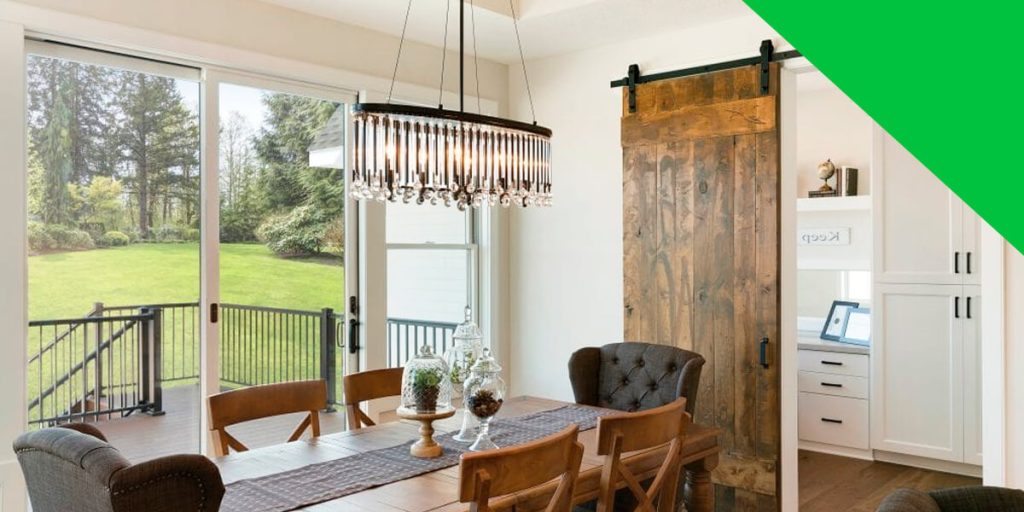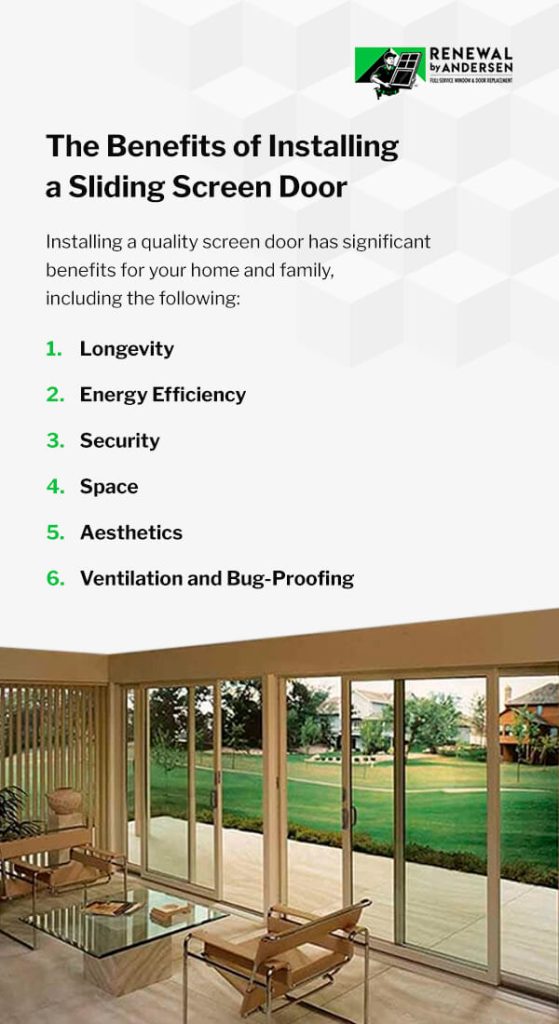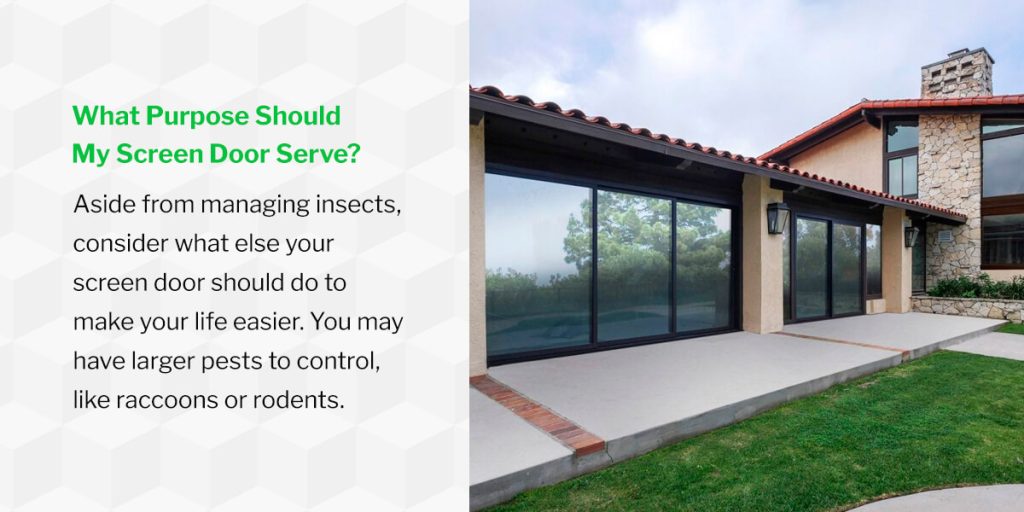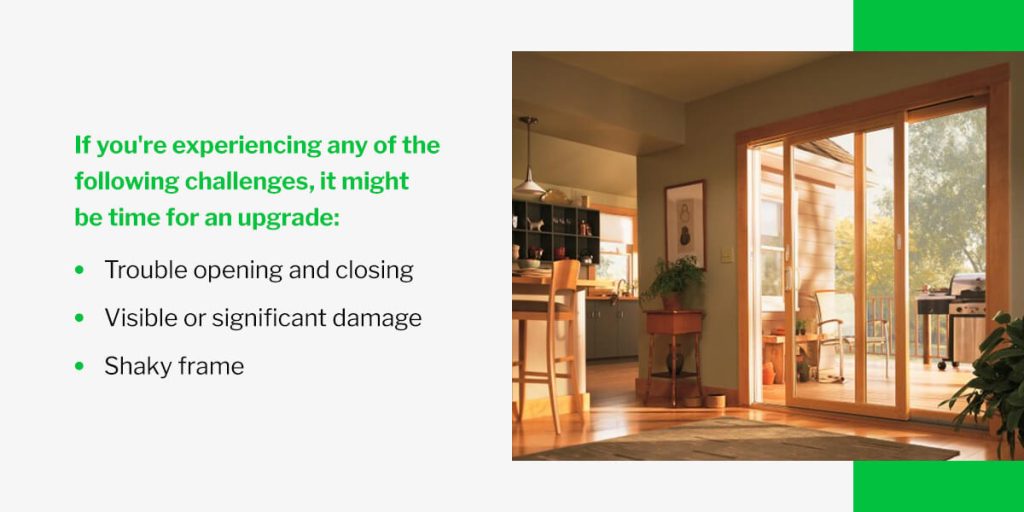MENU


Homeowners are always looking for ideas to enhance functionality and aesthetic appeal in their homes. Installing a screen door could be the perfect way to marry these two objectives. A simple screen for your sliding door can open up your space, get natural airflow in your home and provide an energy-efficient method for cooling the indoor temperature.
In addition, screen doors are essential for keeping pests where they belong — outside. Rodents and insects can cause disease and trigger asthma and allergies. A sliding screen door is an excellent option to help reduce pests in your home while enjoying some fresh air from inside your home.
As the name suggests, a sliding screen door is a sliding door, but the traditional glass panel is replaced with a screen. They are often installed in front of sliding glass doors. Many people use sliding screen doors on patios and decks, as they allow natural light and ventilation without impacting your view of the outdoors.
Screen doors are a popular option in warm climates, allowing air to flow into your home and preventing insects from entering. As they keep bugs out of the house, some countries even use them as a malaria prevention strategy.

Installing a quality screen door has significant benefits for your home and family, including the following:
A good quality screen door can last decades, provided you maintain it.
A sliding screen door can lower energy costs and make your home more efficient. In hot weather, you can open your glass door and allow air to flow through the screen door, reducing the need for air conditioning.
If you want to keep your doors open to allow fresh air into your home, having a sliding screen door means you can remain secure. Screen doors have their own lock, so they provide protection while allowing air in. When you have the screen door and the glass door closed, you can enjoy an extra layer of security.
We all want to make the most of the space in our homes, and a sliding screen door allows you to maximize your interior and exterior space. As they float along a track, they run right along the wall instead of swinging open on a hinge. You don’t need extra space for the door’s arc, making your rooms and porch feel more spacious.
Sliding doors can transform your home, allowing full natural light into your interior and enhancing your view of the outdoors.
Opening screenless doors is like an invitation to insects, especially at night. Sliding screen doors give you access to natural ventilation without the bugs. The screens also help you keep your pets indoors at night, so you can enjoy a breeze without worrying about your furry friend escaping. Learn more about keeping the bugs and critters out in the next section!
Having bugs in your house is a real pain, and although sliding screen doors are an excellent method of keeping them from coming in through the doors, a more detailed approach can help you keep them out altogether. Keep bugs out of the house with the following tips:
If you check your doors and windows, you’ll be shocked at the number of nooks and crannies that serve as entranceways for bugs. Start with sealing the space underneath your door with either a steel or aluminum threshold, a door sweep or both. You can find door seal kits at most hardware stores to prevent bugs from entering through the sides or tops of your doors. You can also seal the area between the door frame and the wall.
Keeping your foundations dry can prevent insects like termites, ants, spiders and fleas from breeding underneath your house. Remove damp piles of leaves or mulch around your foundation, and store wood piles away from the home to avoid tempting termites. As you would with the walls, check for cracks in your foundation and seal these spaces.
The tiniest cracks can be doorways for bugs, and they can quickly gather in gaps in your walls. Scrutinize your home exterior and foundations for cracks, damaged bricks and warped wood. Patch up the walls with mortar and cement, remove and replace damaged wood and bricks, and conduct general maintenance to limit the number of bugs that can get in.
If you’ve ever had to drill through the wall to add a cable, you may have inadvertently created an entrance for insects. Check any wall penetrations, including electrical, gas, water or air conditioning pipes, and fill in small gaps and cracks with caulk or sealant. You can use mesh, steel wool or polyurethane foam if you find larger openings.
There are over 200 species of mosquitos in the United States, making them a common challenge for homeowners. Mosquitos need stagnant water to breed. You can reduce the number around your home by eliminating pooled water from your yard. Look for pooled water in buckets, children’s toys, potted plant trays, tarps and tree holes, as these areas attract mosquitos.
Ensure your gutters and other drainage channels are free from leaves and other debris to prevent water pooling in these areas. Even dry piles of leaves, grass cuttings and other debris can make excellent breeding grounds for other insects, so remove those as well. If you have a pool, keep it chlorinated. Also, change the water in your bird baths or fountains regularly.
With so many tiny openings, it’s easy to overlook the large ones like chimneys and vents. For these, you can get fine wire mesh, staple it over and replace your vents with meshed models to prevent extra work in the future.
Limiting the entrance points can go a long way to restrict the number of bugs in your home, but they often find their way in regardless. Make your residence as unappealing as possible to bugs with these tips:
A dark, moist area full of food is the perfect home for bugs. Keep your trash in one container with a lid and empty it every night to prevent bugs from moving in. Clean and sterilize your bins regularly, and line your compost bin with hardware to keep them from getting too comfortable.
One of the easiest ways to manage the bug population is to let nature take its course. Insects are an excellent source of food for birds and bats. You can encourage them into your environment by providing safe spaces to nest and a supply of food and water. Consider installing bird feeders and a bat roost in your yard.
Aside from sliding screen doors, you can install screens on your windows. If you already have screens, check them for even the smallest tears. Bugs only need a tiny space to get into your home, so ensure none of the screens are torn, and repair or replace any torn sections.
Screen doors are a significant part of the solution if you’re serious about minimizing insects in your home. However, your screen door should do more than keep bugs at bay. Ask yourself the following questions to help find the right screen door:

Aside from managing insects, consider what else your screen door should do to make your life easier. You may have larger pests to control, like raccoons or rodents. If you have pets, they often scratch the screen when they want to get in or out. Screens come in various materials, so you can choose one that suits your requirements.
Think about how much light you want. Depending on your preferences, you can choose opaque screens or screens you can see through. If security is a concern, you can find screens with extra layers for your peace of mind.
When you know your screen door’s purpose, you can choose a mesh that can keep up with your lifestyle. There are many types of mesh to suit homeowners’ needs, the most common of which include the following:
Frames are made from various materials, but wood, metal and plastic are the most common. Each has its pros and cons:
It’s best to consult a professional to help install your sliding screen door, as installing the track correctly can be tricky. However, installing it yourself is possible for DIY enthusiasts with the right tools.
Sliding screen doors should be functional and stylish, and your doors make a statement when chosen correctly. The last thing you want is for your screen door to detract from your home’s appeal, and choosing the right color can make all the difference to the exterior.
You have many colors to choose from and can often have frames painted in any color you like. However, some classic, neutral colors include white, beige, brown, black and grey. White is a more traditional color for a screen door, as it works with houses of any color and gives your home a fresh, clean look. It’s also easy to repaint.
Black is also a great color, especially if you want to accentuate the door and make it a feature. Beige and brown have the opposite effect, creating a neutral frame that blends into the rest of the house and draws less attention. However, your color choice is entirely up to you.

Over time, exposure to the elements causes wear and tear to your screen door — eventually, you’ll need to replace it. If you’re experiencing any of the following challenges, it might be time for an upgrade:

A quality sliding screen door can make your home more comfortable, enhance your view, increase energy efficiency and boost your aesthetic. However, if the glass door behind it is sticky, worn, poorly installed or broken, the sliding screen door won’t look as nice.
Renewal by Andersen can help you find replacement sliding doors that will beautifully complement your new screen door. We offer professional installation in many locations, excellent quality and performance, and unrivaled elegance from design to delivery. We’re also committed to giving you the best customer service possible. You can get all the assistance you need when adding a replacement door to your home. Contact us to learn more about our replacement sliding doors today!